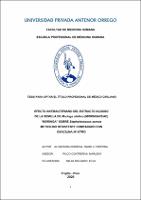Mostrar el registro sencillo del ítem
Efecto antibacteriano del extracto acuoso de la semilla de Moringa oleifera (Moringaceae) “Moringa” sobre Staphylococcus aureus meticilino resistente comparado con Oxacilina in vitro
| dc.contributor.advisor | Pilco Contreras, Marleny | |
| dc.contributor.author | Alcantara Noriega, Danelli Cristina | |
| dc.creator | Alcantara Noriega, Danelli Cristina | |
| dc.date.accessioned | 2020-07-08T20:54:22Z | |
| dc.date.available | 2020-07-08T20:54:22Z | |
| dc.date.issued | 2020 | |
| dc.identifier.uri | https://hdl.handle.net/20.500.12759/6355 | |
| dc.description.abstract | OBJETIVO: Evaluar si el efecto antibacteriano del extracto acuoso de la semilla de Moringa oleifera (Moringaceae) “moringa” sobre cepa de Staphylococcus aureus meticilino resistente es similar al efecto de la oxacilina in vitro . MATERIAL Y MÉTODOS: Estudio experimental. Doble ciego. Preparación del extracto acuoso de la semilla de Moringa oleifera en concentraciones de 30 mg/ml, 60 mg/ml, 90 mg/ml, 120 mg/ml bajo las denominaciones BI, BII, BIII y BIV respectivamente; fueron aplicadas sobre placas inoculadas con Staphylococcus aureus meticilino resistente y como control positivo y negativo se utilizó oxacilina y solución fisiológica (NaCl 0.9%) respectivamente. Se realizó 12 repeticiones para cada concentración a través del método Kirby-Bauer y su clasificación según la Escala de Duraffourd que determinó el efecto inhibitorio. También se halló la Concentración mínima inhibitoria (CMI) correspondiendo al menor nivel de turbidez, fue medido a través de un espectrofotómetro . Estadísticamente se sometió a un análisis de varianza ( ANOVA) y prueba de DUNCAN ambas pruebas con nivel de significancia p < 0.05. RESULTADOS: La medición del nivel de turbidez para hallar CMI dió como resultado 0.027, 0.040, 0.032, 0.024 y 0.024 para BI, BII, BIII, BIV y oxacilina respectivamente. Los promedios de los halos de inhibición para cada concentración son: 17.42 mm para BI; 20.17 mm, BII; 21.00 mm, BIII; 24.92 mm, BIV. Prueba ANOVA muestra diferencia altamente significativa (p < 0.001) entre los tratamientos aplicados. CONCLUSIONES: El efecto antibacteriano del extracto acuoso de la semilla de Moringa oleifera evaluado con la formación de halos de inhibición fue positivo sobre SARM. Existe una diferencia significativa (p <0.05) entre las concentraciones de los extractos y el control positivo (Oxacilina). La concentración mínima inhibitoria le corresponde a la concentración de 120 mg/ml del extracto acuoso de la semilla de Moringa oleifera y al control positivo con oxacilina, demostrando similar efecto inhibitorio en el crecimiento de Staphylococcus aureus meticilino resistente . | es_PE |
| dc.description.abstract | OBJECTIVE: To assess whether the antibacterial effect of the aqueous extract of Moringa oleifera (Moringaceae) ““moringa““ on a strain of resistant methicillin Staphylococcus aureus is similar to the effect of oxacillin in vitro. MATERIAL AND METHODS: Experimental study. Double-blind. Preparation of the aqueous extract of Moringa oleifera seed in concentrations of 30 mg / ml, 60 mg / ml, 90 mg / ml, 120 mg / ml under the names BI, BII, BIII and BIV respectively; They were applied on plates inoculated with resistant methicillin Staphylococcus aureus and oxacillin and physiological solution (NaCl 0.9%) were used as positive and negative control, respectively. 12 repetitions were performed for each concentration through the Kirby-Bauer method and its classification according to the Duraffourd Scale that determined the inhibitory effect. The Minimum Inhibitory Concentration (MIC) corresponding to the lowest level of turbidity was also found, it was measured through a spectrophotometer. Statistically, an analysis of variance (ANOVA) and DUNCAN test were carried out on both tests with a significance level of p <0.05. RESULTS: The measurement of the turbidity level to find MIC was as a result 0.027, 0.040, 0.032, 0.024 and 0.024 for BI, BII, BIII, BIV and oxacillin respectively. The averages of the inhibition halos for each concentration are: 17.42 mm for BI; 20.17 mm, BII; 21.00 mm, BIII; 24.92 mm, BIV. ANOVA test shows highly significant difference (p <0.001) between the applied treatments. CONCLUSIONS: The antibacterial effect of the aqueous extract of Moringa oleifera seed evaluated with the formation of inhibition halos was positive on MRSA. There is a significant difference (p <0.05) between the concentrations of the extracts and the positive control (Oxacillin). The minimum inhibitory concentration corresponds to the concentration of 120 mg / ml of the aqueous extract of the Moringa oleifera seed and to the positive control with oxacillin, demonstrating a similar inhibitory effect on the growth of resistant methicillin Staphylococcus aureus. | en_US |
| dc.description.uri | Tesis | es_PE |
| dc.format | application/pdf | es_PE |
| dc.language.iso | spa | es_PE |
| dc.publisher | Universidad Privada Antenor Orrego - UPAO | es_PE |
| dc.relation.ispartofseries | T_MED.HUMA_2781 | |
| dc.rights | info:eu-repo/semantics/openAccess | es_PE |
| dc.source | Universidad Privada Antenor Orrego | es_PE |
| dc.source | Repositorio Institucional - UPAO | es_PE |
| dc.subject | Efecto antibacteriano | es_PE |
| dc.subject | Moringa oleifera | es_PE |
| dc.title | Efecto antibacteriano del extracto acuoso de la semilla de Moringa oleifera (Moringaceae) “Moringa” sobre Staphylococcus aureus meticilino resistente comparado con Oxacilina in vitro | es_PE |
| dc.type | info:eu-repo/semantics/bachelorThesis | es_PE |
| thesis.degree.level | Título Profesional | es_PE |
| thesis.degree.grantor | Universidad Privada Antenor Orrego. Facultad de Medicina Humana | es_PE |
| thesis.degree.name | Médico Cirujano | es_PE |
| thesis.degree.discipline | Medicina Humana | es_PE |
Ficheros en el ítem
Este ítem aparece en la(s) siguiente(s) colección(es)
-
Medicina Humana [2762]

